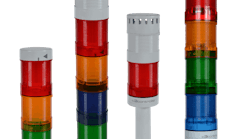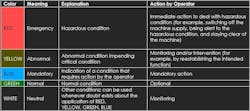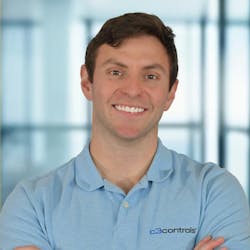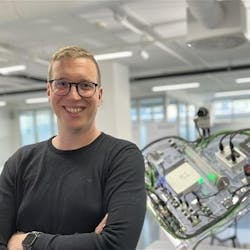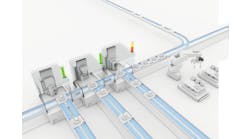A Control Design reader writes: I've seen basic standard stacklight colors on machines for years, but now it seems there are a variety of other colors for various conditions. Are there any downsides to adding colors or flashing patterns? Do they confuse operators? And what about "smart" stacklights with advanced communication technology? Is it overkill, or are we missing an opportunity by not including them on our machines?
Get your subscription to Control Design’s daily newsletter.
Answers
Stick to the stacklight standards
The ability to add and modify light colors for signaling has been a challenge for decades. Consider the automotive arena for a moment before diving into the commercial and industrial arenas. For example, take a look at the automobile brake light. How confusing would it be if we could have any color for brake lights? What if some automotive users installed blue brake lights? Would it convey the same meaning (Figure 1)? What about the color of turn signals? Even in the red spectrum, from pinks to oranges to purples, how many variations of red have you seen for automotive brake lights? The answer should be no variation in color.
Just like there are automotive standards that dictate what the standard light signals shall be, there are commercial and industrial standards that do the same thing. NFPA 79 is the North American standard for electrical and industrial machinery. This standard offers guidance from sizing and selecting appropriate electrical wires and components to marking signs. It also covers requirements that include equipment and controls locations and colors for pushbuttons, operator interfaces and signal lights. This standard also gives the requirements of whether lights should be flashing or not.
For instance, NFPA 70:2021—Section10.2.2 Colors states:
Pushbutton actuators and action initiating icons of color graphic interface devices shall be color-coded in accordance with 10.2.2.1 through 10.2.2.6.
Preceding this, the standard states what red, green, yellow and other colors shall be used for. Keep in mind that in some standards, “should be” or “should have” is a recommendation, whereas “shall be” or “shall have” is a requirement.
Section and Table 10.3.3 gives the requirements for indicator lights (Table 1).
In the appendix of NFPA 79:2021, Section A.10.3.3 gives the color order from top down for stacklights/indicating towers. Indicating towers on machines should have the applicable colors in the following order from the top down:
If we are striving for consistency to minimize confusion, then the standards are what we must follow. Even the color order in NFPA A.10.3.3 can be confusing because the appendix in the standard is not a requirement but a recommendation. Did you catch the “should have” in Section A.10.3.3?
We must strive for consistency, because, in consistency, we find safety. Therefore, we must find a solution that resolves every situation. The International Electrotechnical Commission (IEC) standard helps meet this goal. Unlike the NFPA 79, IEC standards are accepted in Europe and other countries where local standards do not supersede the international standards.
The international electrical standard is IEC 60204-I:2016, and it aligns with NFPA 79 in this case, the general requirements standard for machine safety and electrical equipment of machines. Table 4 in this standard defines each color along with the appropriate recommendation (“should have”) for the color order. As system integrators, we must strive to adopt the required colors along with the recommended color order to eliminate confusion in the event personnel transfers to other companies or industries.
Smart stacklights with advanced communication technology can be helpful to transmit information about production status, maintenance or downtime—for example, from 0 to 100%. The color of these stacklights should be used with respect to the colors indicated by the standards. Again, one must consider consistency to eliminate confusion.
Kerry White, discrete manufacturing industry leader / Hargrove Controls & Automation, system integrator in Mobile, Alabama, certified member of the Control System Integrators Association (CSIA)
Lean-manufacturing tool
Light indicators are essential tools for manufacturing equipment; they offer significant benefits for visual management, especially when integrated with andon systems. The use of LED technology provides color flexibility beyond the traditional green, yellow and red signals. This adaptability allows companies to tailor light indicators to their specific andon needs and processes, enhancing the overall efficiency of visual management.
Andon is a key component in lean manufacturing, serving as a visual management system that alerts operators and managers to deviations on the production line or within a cell in real time (Figure 2). This immediate notification enables the activation of deviation management processes, which are crucial for maintaining production flow.
The ability to customize light signals to match a site's unique visual management requirements is a major advantage, as it facilitates quick reactions to deviations and reduces lead times. This is particularly effective when the system is linked to an electronic communication network, such as text messaging or email alerts.
For this system to be effective, it's critical that operators and the support team are thoroughly trained on the significance of the light colors and the andon process. With proper training, the risk of confusion is minimized, ensuring that everyone responds promptly and appropriately to the signals, thereby maintaining smooth operations.
Rafa Paredes, general manager / Bosch Rexroth
Keep your stacklights simple
When we talk about colors and flashing patterns for stacklights, there are standard practices which are common to the industry. However, each organization may have different needs. Fewer colors and flashing patterns allow for simplicity, while more colors and flashing patterns allow for more explicit communication of the status or issue.
Adding colors or flashing patterns can have both benefits and downsides. Some downsides of adding more colors could include increasing the height of the stacklight when there is not adequate room available or reducing visibility and line of sight to all of the colors in the stack (Figure 3). Adding flashing patterns can have downsides, as well, such as confusion due to the difficulty of distinguishing between different flashing patterns. With these downsides being noted, clear documentation and proper training can mitigate any confusion to operators, technicians, production managers and manufacturing support staff.
One thing that is often left out of this discussion is consideration of the number of people who are colorblind, which is about 8% of the male population. That means that the possibility of one out of every 10 employees would find multiple colors worthless, or even dangerously confusing. We have all heard of the KISS acronym—keep it simple, stupid. With stacklights, remember KYSS—keep your stacklights simple.
The Americans With Disabilities Act (ADA) considers color blindness a disability that you would need to make accommodations for (Figure 4). Someone with colorblindness would need to remember the position of the colors. Having too many colors in the stack could lengthen reaction time.
Another consideration is a worker with a seizure disorder. Would a flashing light trigger a seizure? Do you know if any of your workers have a disorder? Are you allowed to ask? My point is that there is more to the colors-and-flashing-patterns question that goes beyond a simple analysis and needs to be considered for your particular work environment and the litigious times we live in.
While “smart” stacklights are clearly the wave of the future, they require more effort during planning, procuring, initial setup and maintenance. Smart stacklights, with nearly unlimited options, can allow for maximum customization and specificity but also decision paralysis and more difficult troubleshooting.
Although these last points represent both pros and cons, the advanced communication technology associated with smart stacklights is most certainly a positive feature which can be leveraged for optimum results. For example, in a scenario where the primary manufacturing support staff or design engineers are not located within line of sight of the equipment, the advanced communication technology can alert those personnel, no matter where they are decreasing the time for resolution and maximizing equipment uptime.
In my opinion, whether smart stacklights are overkill or an opportunity depends on each organization's needs, as well as the infrastructure to support it.
Neil Buzzard, global product marketing manager / c3controls
Leverage your options
There are many different types of stacklights, also called light towers. They range from very basic lights to advanced communication devices; they vary in size and function. There are single-tier and up to five- and six-tier towers, all with different options; some flash or have alarms and buzzers, some have programmable colors and patterns. Depending on your application and specific function needs, you may only need something very basic, but many customers today are looking for all-in-one type products, which gives them flexibility in application. Color variations other than standard red, yellow and green give additional flexibility for specific communication, especially in industrial environments where there are other lights and something that will stand out is needed. Various colors also allow more specific and detailed information on machine status or problems. Green usually means things are working, everything is operating correctly; yellow may indicate a warning; and red may indicate an emergency or another type of problem, somewhat similar to a traffic light. Often there is a need for other colors for other situations so you may see blue or white lights. Blue and white can often be used in a safety area, or they can be used to customize application-specific needs, such as when a machine is off-line or not in use. Flashing colors can be used to designate severity of situations; for example, red could indicate a machine issue, but flashing red could indicate an emergency or a catastrophic failure of some sort.
Additional colors and functions can be very useful; it’s important to have all workers trained on the meanings of stacklights, regardless of which type is used. This will eliminate any confusion.
As technology has advanced, so has the communication ability of stacklights. As with most things now there are various options of smart and IIoT-enabled stacklights. There are many benefits to these in today’s connected world. Remote monitoring is an increasingly needed function. Now, individuals can see status and colors of light towers remotely, without even being in the facility, if necessary, allowing them to better monitor multiple or large facilities (Figure 5).
Real-time monitoring is a benefit that goes hand in hand with remote monitoring; advanced stacklights can provide instant feedback. Data collection is another valuable function of smart stacklights. Data can be monitored and collected over periods of time and stored so it can be analyzed and used for predictive maintenance (Figure 6).
Will Morris, category manager / RS
Simple and smart
Stacklights use different colors to convey specific information about machine status or process conditions. This evolution of stacklights from conventional red, yellow and green to a wider palette of colors and advanced functionality presents both opportunities and challenges for the industrial environment. For example, an unwell-trained operator may misread the color display. Also, an operator with color-vision deficiencies may encounter some problems in distinguishing between some colors, which can lead to safety risks. The stacklight usually flashes to alert the operators about any impending danger. With more colors and flashing signals, there is a good likelihood that operators might become complacent with the alerts that can easily be ignored. Too many signals result in information overload, making it harder for workers to prioritize alerts.
Therefore, adopting best practices becomes crucial. It's important to limit the introduction of new colors and have a standard meaning of the color throughout the facility. Complementing the visual signals, for example, with audible alarm or HMI display, would enhance this kind of messaging. Regular training to make the operators aware of what these signals mean would also reduce confusion and enhance safety.
Smart stacklights offer real-time monitoring, customizable colors, audible alarms and analytics by integrating with IoT systems. They can send data to remote locations, providing alerts on machine conditions, predictive maintenance and performance trends. They enhance troubleshooting, safety and efficiency through detailed machine-health insights. Is it overkill? No. Smart stacklights allow for scalable, data-driven systems that improve operational efficiency. Their flexibility and ability to track trends, reduce downtime and optimize workflows give factories a competitive edge.
Cliff Ortmeyer, head of solutions / Newark
Benefits plus flexibility
The biggest benefit of using a stacklight is its ability to provide visual indication and status information in industrial environments (Figure 7). Smart signal towers offer this benefit plus some added flexibility. Not only can you adjust the color display as you wish, but you can also configure the segment size.
Where older signal towers rely on fixed color and segment setup—red, green, yellow in three equally sized segments—many newer models can be quickly and easily adjusted to show more information. With that technology, the color signals can be more clear and powerful than with standard towers—for example, the color/segment could be larger. You can define the colors and segment size to display critical machine and equipment status (Figure 8).
In case of many different colors, some customers might add extra text displays beside the lamps. On the other hand, with the smart versions, you can still use the standard feature set with seven standard RGB colors. Basically, smart versions deliver all the benefits and features of the standard signal towers but with more flexibility. Therefore, another plus is that you do not need so many different materials in your storage.
The use of advanced communication technologies is a trending topic (Figure 9). There are many changes happening in the industry in that regard, and it’s important to evaluate which technology makes sense or adds extra value. Whether it is worth it to add them to your machines becomes a case-by-case decision, but, overall, they are a good value and a simple way for adding visualization of important, sometimes critical, machine information.
Tobias Wiens, product manager / Balluff
